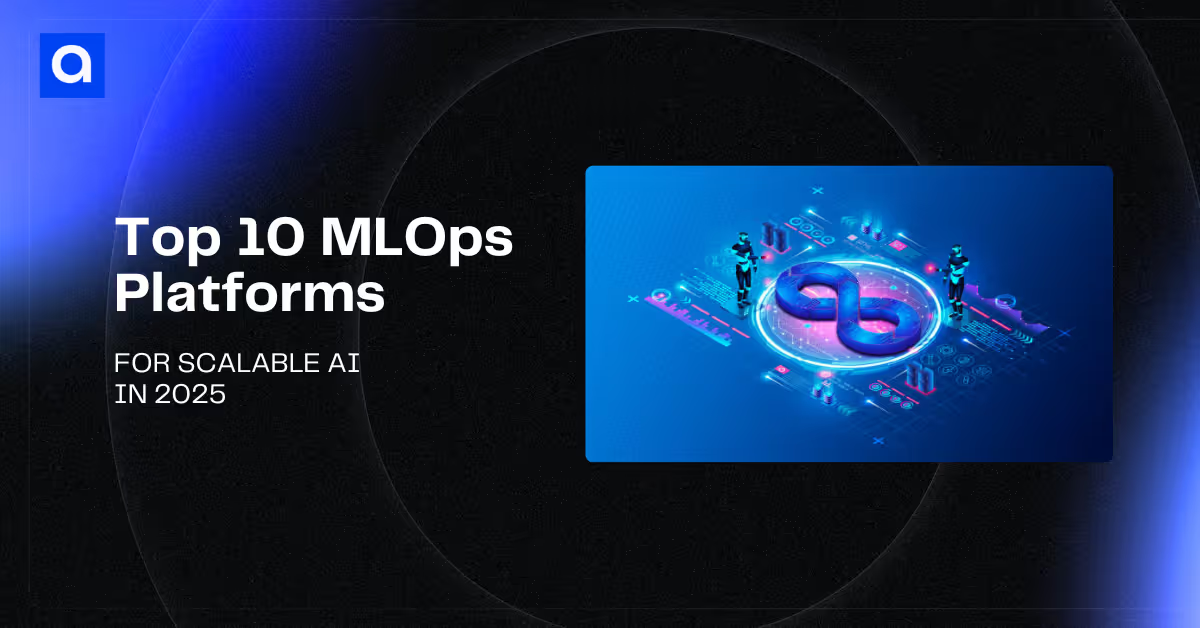
The MLOps market is experiencing explosive growth, with valuations reaching $1.7 billion in 2024 and projected to soar to $129 billion by 2034, a staggering 43% compound annual growth rate that reflects the urgent need for scalable AI infrastructure. As organizations race to deploy machine learning models at enterprise scale, choosing the right MLOps platforms has become mission-critical for competitive advantage. Despite the increasing demand, only a small percentage of organizations have fully mature MLOps capabilities, highlighting a significant opportunity for teams that can effectively bridge the gap between model development and production deployment.
The stakes couldn't be higher: companies implementing proper MLOps report 40% cost reductions in ML lifecycle management and 97% improvements in model performance. Yet with hundreds of tools flooding the market, selecting the optimal platform requires understanding each solution's unique strengths, integration capabilities, and scalability limits. This comprehensive analysis examines the ten most impactful MLOps platforms transforming how organizations build, deploy, and manage AI systems in 2025.
Platform Comparison Overview
Enterprise Cloud Platforms Leading Market Consolidation
1. AWS SageMaker - Enterprise Cloud MLOps Leader
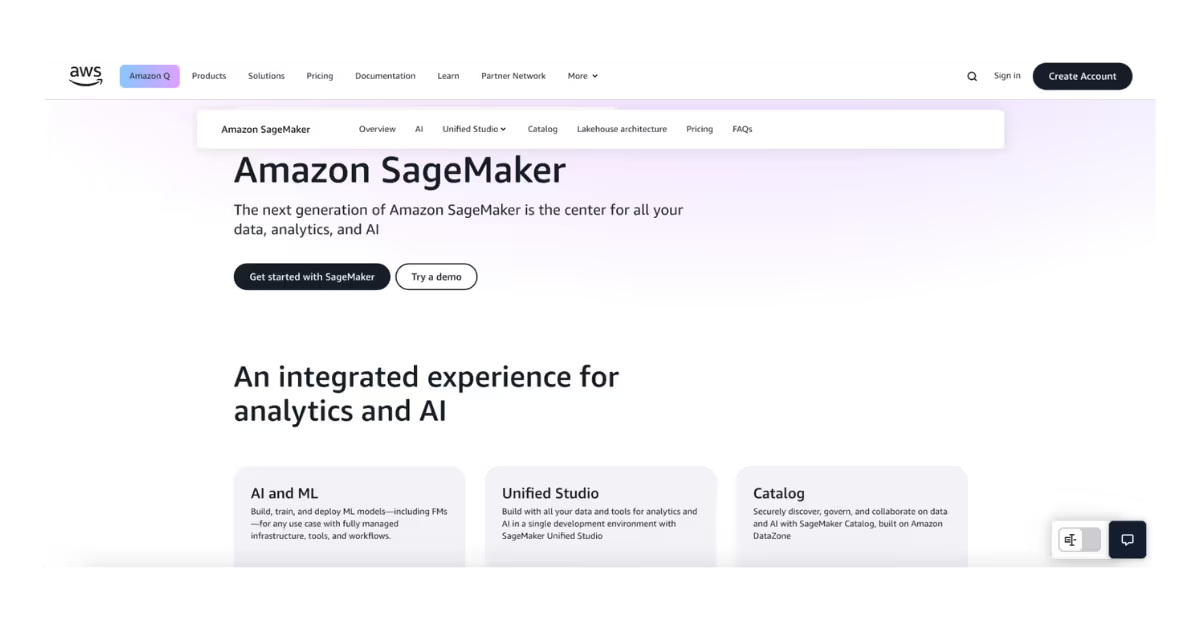
AWS SageMaker dominates the enterprise MLOps landscape with its comprehensive suite of tools designed for every stage of the machine learning lifecycle. The platform excels at bridging data science and production operations through an integrated development environment that reduces deployment friction while maintaining enterprise-grade security and compliance features.
Key Features:
- One-Click Model Deployment: Simplified deployment process that transforms trained models into production-ready endpoints with automatic scaling, load balancing, and A/B testing capabilities built-in.
- SageMaker Model Monitor: Real-time drift detection and model performance monitoring that automatically identifies data quality issues, feature drift, and bias detection across deployed models.
- Multi-Model Endpoints: Cost-efficient serving architecture that allows hosting multiple models on a single endpoint with automatic routing and resource optimization based on traffic patterns.
- SageMaker Pipelines: Automated workflow orchestration with deep integration into AWS CodePipeline, enabling sophisticated CI/CD workflows for machine learning model deployment and management.
- Comprehensive Algorithm Library: Over 150 built-in algorithms and pre-trained models covering computer vision, natural language processing, and traditional machine learning use cases.
Use Cases:
- Enterprise Model Deployment: Large organizations deploying dozens of production models across multiple business units with strict governance, compliance, and security requirements.
- Real-time Inference Systems: Applications requiring low-latency model serving such as fraud detection, recommendation engines, and dynamic pricing systems with millisecond response times.
- Automated ML Workflows: Teams implementing continuous integration and deployment for machine learning models with automated testing, validation, and rollback capabilities.
Real-World Example
Netflix enhanced their recommendation system using SageMaker's continuous deployment capabilities, enabling them to test and deploy new recommendation algorithms across their global user base while maintaining 99.9% uptime and reducing model deployment time from weeks to hours.
Pricing
AWS's pay-as-you-go model with compute instances ranging from $0.05 to $24.48 per hour, plus storage and data processing costs. The platform offers substantial savings through reserved instances (up to 64% discounts) and includes a generous 2-month free tier with 250 hours of notebooks and 50 hours of training.
Bottom Line
AWS SageMaker provides the most comprehensive enterprise MLOps platform for organizations already invested in the AWS ecosystem, offering unmatched scalability and integration depth. Ideal for teams requiring enterprise-grade security, compliance, and global infrastructure with willingness to invest in AWS-specific expertise.
2. Google Vertex AI - AI-First Unified Platform
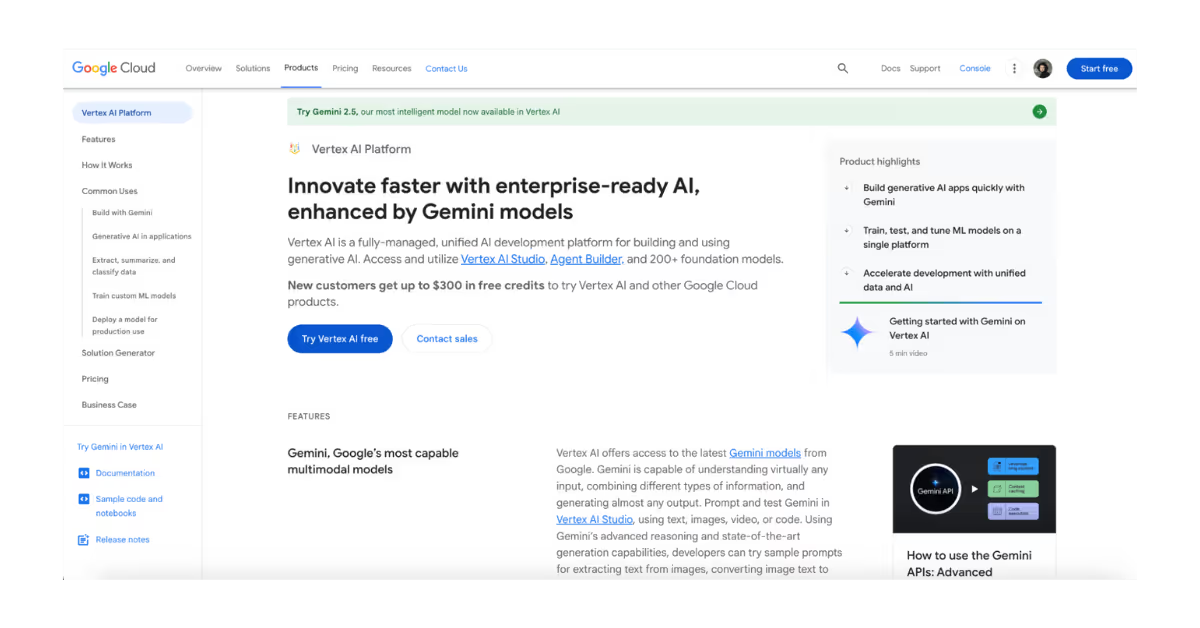
Google Vertex AI represents Google's unified approach to artificial intelligence, combining AutoML capabilities with advanced research integration and superior natural language processing tools. The platform particularly excels for organizations prioritizing ease of use while maintaining access to cutting-edge AI research and Google's foundation models.
Key Features:
- Model Garden Integration: Access to 200+ pre-trained models including Google's Gemini, PaLM, and specialized industry models with simple API integration and fine-tuning capabilities.
- Vertex AI AutoML: No-code machine learning for tabular, image, text, and video data that enables business users to build production-ready models without extensive technical expertise.
- Agent Builder: Conversational AI development platform for building sophisticated chatbots and virtual assistants with natural language understanding and multi-turn dialogue capabilities.
- Vertex AI Workbench: Collaborative notebook environments with built-in data science tools, version control, and seamless integration with Google Cloud services and BigQuery analytics.
- TPU Integration: Native support for Tensor Processing Units providing significant performance advantages for large-scale model training and inference workloads.
Use Cases:
- AI-First Product Development: Companies building AI as core product functionality rather than support features, requiring rapid experimentation and deployment of cutting-edge models.
- Document and Language Processing: Organizations processing large volumes of unstructured text data for insights, automation, and content generation across multiple languages.
- Computer Vision Applications: Retail, manufacturing, and healthcare organizations implementing image recognition, quality control, and automated inspection systems.
Real-World Example
According to the Google Cloud Blog, Deutsche Bank improved document processing accuracy by 90% using Vertex AI's natural language processing capabilities, enabling automated contract analysis and regulatory compliance checking across millions of financial documents.
Pricing
Google's pay-per-use pricing without upfront commitments, with training compute, prediction serving, and API calls billed separately. New customers receive $300 in credits for 90 days, while committed use discounts provide up to 57% savings for predictable workloads.
Bottom Line
Google Vertex AI delivers the most accessible path to advanced AI capabilities with strong AutoML features and cutting-edge research integration. Best suited for organizations prioritizing ease of use, natural language processing, and access to Google's latest AI innovations.
3. Azure Machine Learning - Microsoft Ecosystem Integration
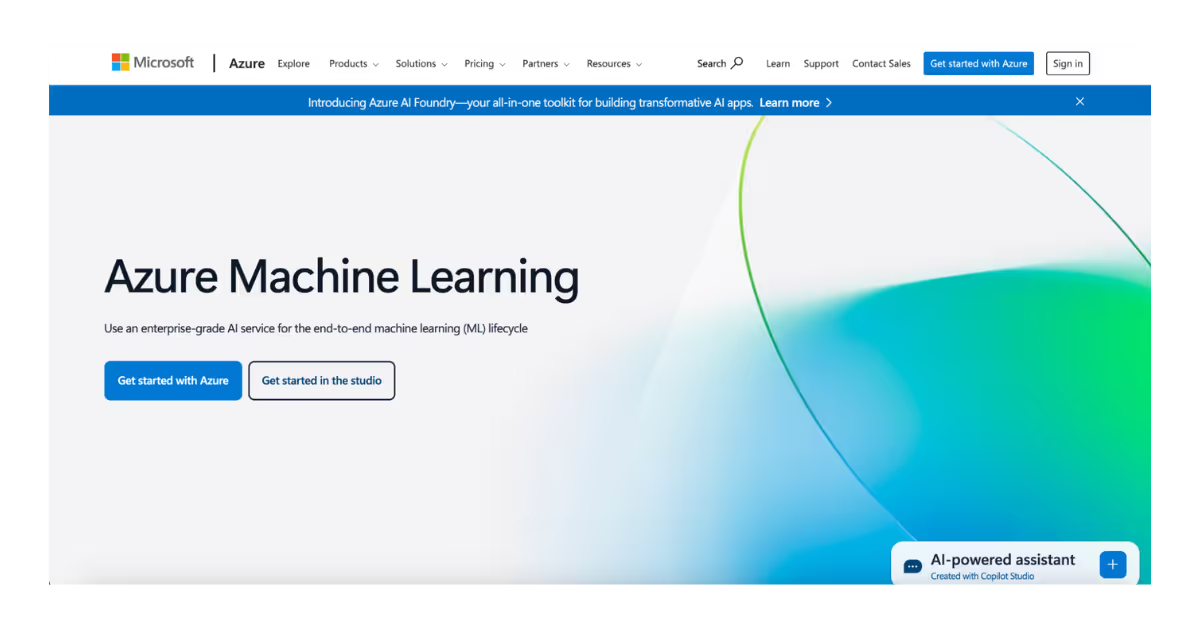
Azure Machine Learning stands out for its seamless integration with Microsoft's ecosystem and unique pricing model that charges only for underlying compute resources rather than platform fees. This approach makes it particularly attractive for cost-conscious organizations already invested in Microsoft infrastructure and productivity tools.
Key Features:
- No Platform Fees: Unlike competitors, Azure ML charges only for virtual machines, storage, and networking without additional platform licensing costs, significantly reducing total cost of ownership.
- Visual Designer Interface: Drag-and-drop machine learning pipeline builder that enables citizen data scientists to create sophisticated workflows without coding expertise.
- Azure DevOps Integration: Native CI/CD pipeline integration with Azure DevOps, GitHub Actions, and Microsoft's development toolchain for automated model testing and deployment.
- Responsible AI Dashboard: Built-in tools for model explainability, fairness assessment, and bias detection to help organizations meet governance and regulatory requirements.
- Hybrid Cloud Deployment: Azure Arc enables consistent model deployment across on-premises, edge, and multi-cloud environments with unified management and monitoring.
Use Cases:
- Microsoft-Centric Organizations: Companies heavily invested in Office 365, Teams, Power BI, and other Microsoft tools seeking seamless workflow integration
- Cost-Optimized Deployments: Organizations requiring enterprise MLOps capabilities while minimizing platform costs through compute-only billing models
- Hybrid and Edge Computing: Manufacturing, retail, and IoT applications requiring model deployment across distributed environments with offline capabilities
Real-World Example
According to the Microsoft Azure Blog, Marks & Spencer scaled machine learning solutions across 30+ million customers using Azure ML's integration with their existing Microsoft infrastructure, enabling personalized marketing campaigns and inventory optimization while reducing platform costs by 40%.
Pricing
Organizations pay only for virtual machines ($0.10-$13.83/hour), storage, and networking. Reserved instances provide up to 72% savings for committed workloads, while the $200 credit for new accounts enables substantial experimentation.
Bottom Line
Azure Machine Learning provides the most cost-effective enterprise MLOps solution for Microsoft-centric organizations, eliminating platform fees while delivering comprehensive functionality. Perfect for teams seeking tight integration with Microsoft productivity tools and hybrid deployment capabilities.
4. Databricks MLflow - Data-Centric ML Operations

Databricks MLflow combines the flexibility of open-source MLflow with enterprise-grade infrastructure built on Apache Spark's distributed computing foundation. This platform excels for data-heavy organizations requiring unified analytics and machine learning capabilities across massive datasets.
Key Features:
- Lakehouse Architecture: Unified platform combining data warehouse performance with data lake flexibility, eliminating data silos and enabling real-time analytics alongside ML workflows.
- Unity Catalog Integration: Comprehensive data governance with fine-grained access controls, lineage tracking, and metadata management across all data and ML assets.
- Mosaic AI Model Serving: Production-grade model deployment with auto-scaling, A/B testing, and real-time monitoring optimized for high-throughput inference workloads.
- Delta Lake Versioning: Time-travel capabilities for data and model versioning, enabling reproducible experiments and rollback capabilities for production models.
- Distributed Training: Native Apache Spark integration for training models across massive datasets with automatic parallelization and resource optimization.
Use Cases:
- Big Data Analytics: Organizations processing terabytes of data daily requiring unified analytics and machine learning workflows across structured and unstructured datasets.
- Real-time ML Pipelines: Companies needing streaming analytics and real-time model inference for fraud detection, recommendation systems, and IoT applications.
- Data Science at Scale: Large teams requiring collaborative development environments with shared compute resources and comprehensive experiment tracking.
Real-World Example
According to Databricks, Shell accelerated their AI/ML model development by 10x using Databricks MLflow, deploying over 100 production models for predictive maintenance, supply chain optimization, and energy trading across their global operations.
Pricing
Usage-based pricing follows Databricks Unit (DBU) consumption, with Standard at $0.40/DBU, Premium at $0.55/DBU, and Enterprise at $0.60/DBU. Serverless options at $0.95/DBU include compute costs, while volume discounts reduce expenses for large-scale deployments.
Bottom Line
Databricks MLflow delivers the most powerful solution for data-intensive machine learning workflows, combining open-source flexibility with enterprise-grade infrastructure. Ideal for organizations with large datasets requiring unified analytics and ML capabilities.
Open-Source Foundations Driving Innovation
5. MLflow - Framework-Agnostic ML Lifecycle
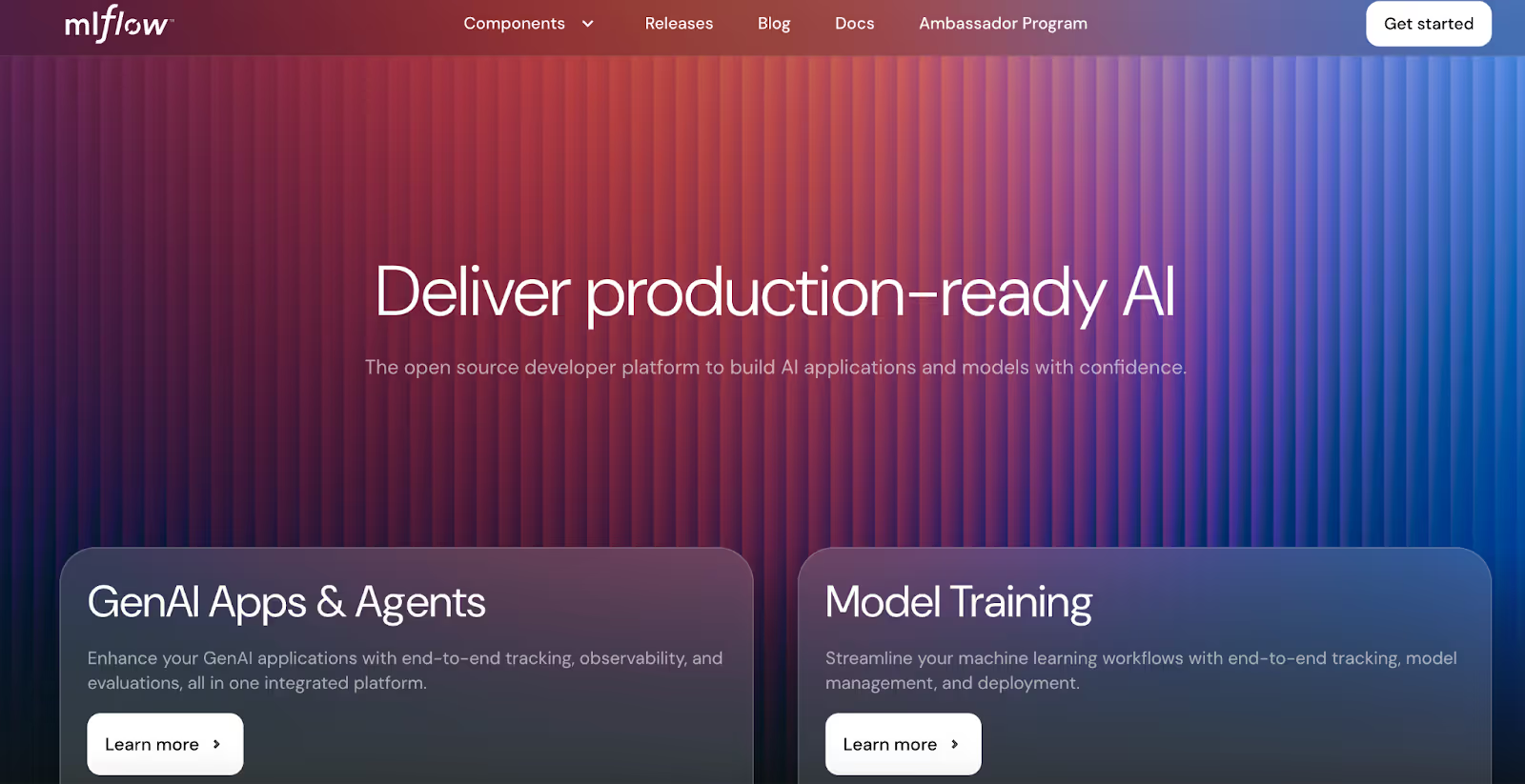
MLflow has emerged as the de facto standard for open-source experiment tracking and model lifecycle management, with over 20,000 GitHub stars and 14 million monthly downloads. Its framework-agnostic approach enables teams to maintain flexibility while building comprehensive MLOps workflows without vendor lock-in.
Key Features:
- Experiment Tracking: Comprehensive parameter, metric, and artifact logging with automatic capture of code versions, environment details, and model performance across all experiments
- Model Registry: Centralized repository for model versioning, stage transitions (staging, production, archived), and collaborative model management with approval workflows
- Model Packaging: Standardized format for packaging models with dependencies, enabling consistent deployment across different environments and platforms
- Flexible Deployment: Support for deployment to cloud platforms (AWS, Azure, GCP), on-premises servers, Kubernetes clusters, and edge devices through pluggable deployment architecture
- Plugin Ecosystem: Extensible architecture supporting custom integrations, storage backends, and deployment targets while maintaining compatibility with existing toolchains
Use Cases:
- Startup ML Development: Cost-conscious organizations requiring comprehensive MLOps capabilities without licensing fees or vendor commitments
- Research and Academia: Universities and research institutions needing flexible experimentation platforms with complete data ownership and customization capabilities
- Multi-Cloud Strategies: Organizations avoiding vendor lock-in while maintaining consistent MLOps workflows across different cloud providers and on-premises infrastructure
Real-World Example
Netflix uses MLflow for recommendation system development and deployment, enabling their data science teams to track thousands of experiments while maintaining consistent model packaging across their microservices architecture.
Bottom Line
MLflow provides the most flexible and cost-effective foundation for MLOps workflows, ideal for organizations prioritizing vendor independence and customization capabilities. Best suited for teams with technical expertise willing to manage infrastructure in exchange for complete control.
6. Kubeflow - Kubernetes-Native ML Platform
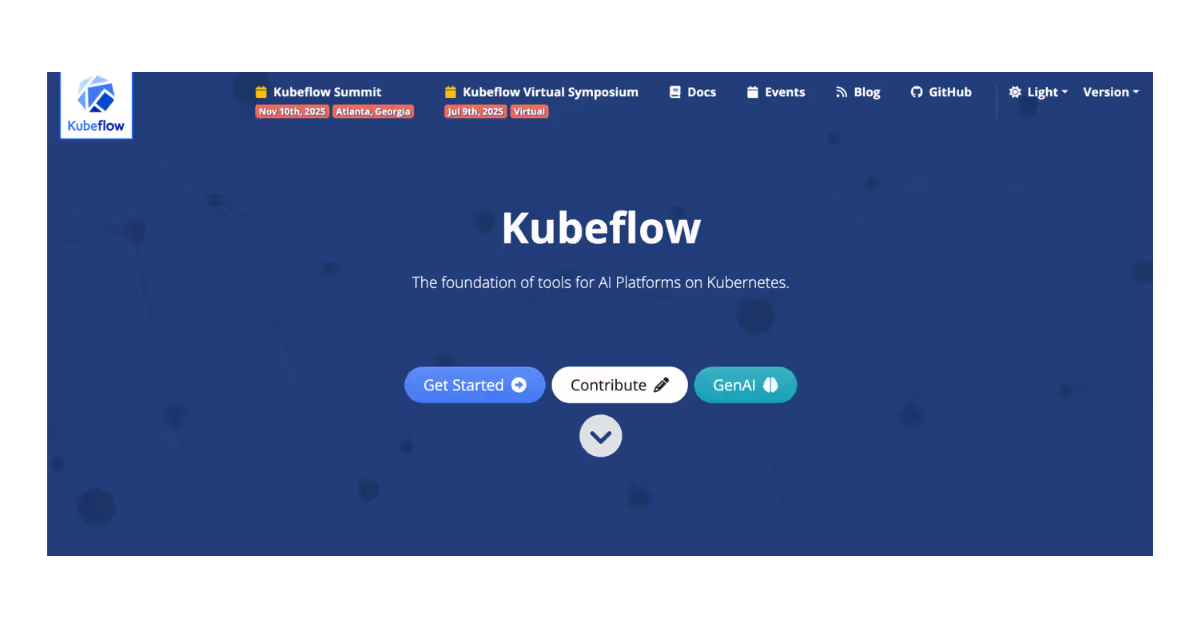
Kubeflow represents the most comprehensive Kubernetes-native MLOps platform, designed for organizations with existing container orchestration expertise seeking cloud-scale machine learning capabilities. As a Cloud Native Computing Foundation project, it benefits from strong community governance and enterprise backing.
Key Features:
- Kubeflow Pipelines: Workflow orchestration system enabling complex ML pipelines with dependency management, parallel execution, and automatic retries built on Argo Workflows
- Distributed Training Operators: Native support for TensorFlow, PyTorch, and XGBoost distributed training with automatic resource allocation and fault tolerance
- KServe Model Serving: Production-grade inference serving with auto-scaling, canary deployments, and traffic splitting for A/B testing across Kubernetes clusters
- Multi-Tenant Notebooks: Collaborative development environments with resource isolation, GPU scheduling, and integration with JupyterHub for team-based development
- Custom Resource Definitions: Kubernetes-native approach using CRDs for ML workflows, enabling integration with existing Kubernetes tooling and DevOps practices
Use Cases:
- Cloud-Native Organizations: Companies with existing Kubernetes expertise requiring ML capabilities that integrate seamlessly with container-based infrastructure
- Multi-Cloud Deployments: Organizations needing consistent ML workflows across AWS EKS, Google GKE, Azure AKS, and on-premises Kubernetes clusters
- Scalable ML Infrastructure: Teams requiring sophisticated resource management, GPU scheduling, and horizontal scaling for large-scale model training and inference
Real-World Example
According to GitHub Kubeflow and Kubeflow documentation, Uber built their ML platform infrastructure on Kubeflow, enabling thousands of data scientists to collaborate on models for ride matching, pricing optimization, and fraud detection across their global operations.
Bottom Line
Kubeflow delivers the most sophisticated Kubernetes-native MLOps platform for container-savvy organizations, providing enterprise-grade scalability with cloud-native best practices. Perfect for teams with DevOps expertise seeking tight integration with existing Kubernetes infrastructure.
Specialized Platforms Targeting Specific Use Cases
7. Weights & Biases - AI Research and Development Platform

Weights & Biases has established itself as the leading AI developer platform, trusted by 30+ foundation model builders including OpenAI, MidJourney, and Cohere. The platform's community-centric approach and comprehensive LLMOps capabilities make it essential for cutting-edge AI research and development organizations.
Key Features:
- Foundation Model Training: Specialized tooling for large-scale model training with real-time GPU utilization monitoring, memory optimization, and distributed training coordination
- Hyperparameter Sweeps: Bayesian optimization and grid search capabilities for automated hyperparameter tuning with parallel execution across multiple compute resources
- Weave LLM Evaluation: Comprehensive evaluation framework for large language models including prompt engineering, fine-tuning assessment, and production monitoring
- Collaborative Experiment Sharing: Team-wide experiment visibility with automated report generation, model comparisons, and integrated version control for reproducible research
- W&B Launch: Automated job packaging and deployment system that handles environment setup, dependency management, and execution across cloud providers
Use Cases:
- Foundation Model Development: Organizations building large language models, computer vision models, and multimodal AI systems requiring specialized training infrastructure
- AI Research Teams: Academic and corporate research groups needing comprehensive experiment tracking with collaboration features and publication-ready visualizations
- LLM Fine-tuning and Evaluation: Companies adapting foundation models for specific use cases requiring systematic evaluation and optimization workflows
Real-World Example
OpenAI uses Weights & Biases for training and evaluating their GPT models, enabling their research team to track experiments across massive computational resources while maintaining detailed performance metrics and model comparisons.
Pricing
Unlimited experiments and storage with free public projects, $50/user/month for private team projects, and custom enterprise pricing for advanced security and compliance features.
Bottom Line
Weights & Biases provides the most comprehensive platform for AI research and foundation model development, with unmatched community support and specialized tooling. Ideal for teams pushing the boundaries of AI capabilities and requiring sophisticated experiment management.
8. Neptune.ai - Foundation Model Training Specialist
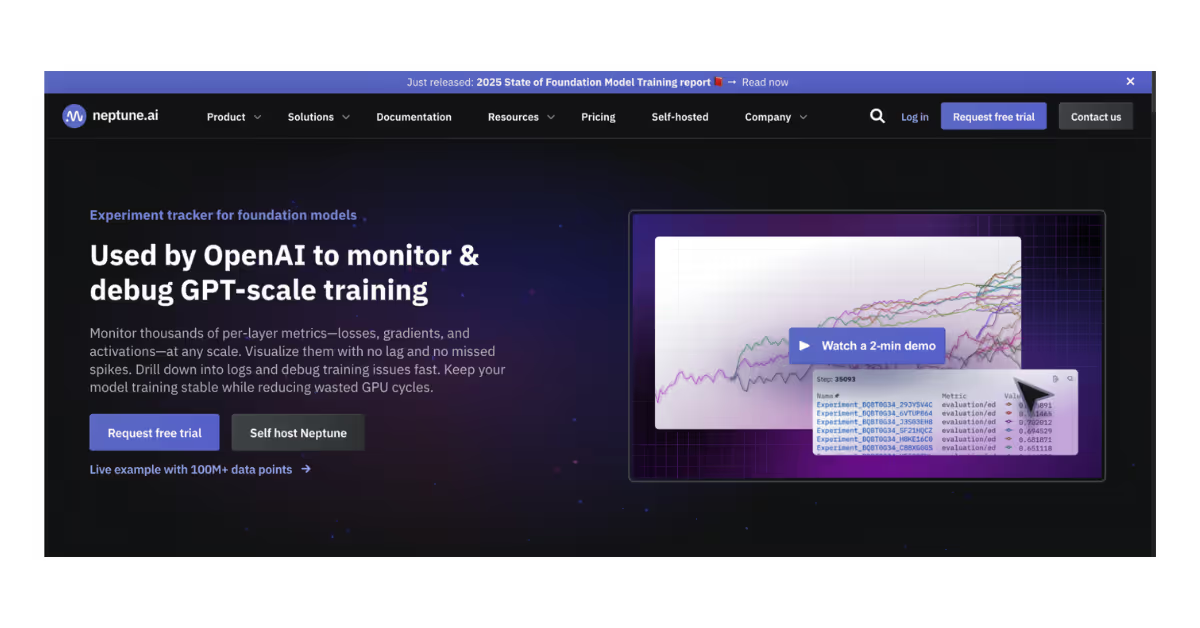
Neptune.ai specializes in foundation model training and large-scale experiment tracking, offering layer-level monitoring capabilities unmatched by general-purpose platforms. The platform tracks thousands of per-layer metrics including losses, gradients, and activations with 100% accurate chart rendering for models ranging from billions to trillions of parameters.
Key Features:
- Layer-Level Monitoring: Detailed tracking of individual layer performance including gradient norms, activation patterns, and convergence metrics for deep neural networks
- High-Volume Data Handling: Capability to handle 100M+ data points per 10 minutes without downsampling, ensuring complete visibility into training spikes and convergence patterns
- Real-Time Training Visibility: Live monitoring of training processes with instant alerts for divergence, NaN values, and performance degradation across distributed training jobs
- Automated Experiment Lineage: Complete tracking of experiment relationships, including forked experiments, dataset versions, and model evolution across research iterations
- Self-Hosted Deployment: On-premises and private cloud deployment options for security-sensitive environments requiring complete data control and compliance
Use Cases:
- Large-Scale Model Training: Organizations training models with billions to trillions of parameters requiring detailed monitoring and optimization insights
- Research and Development: Teams iterating on novel architectures requiring comprehensive experiment tracking and performance analysis capabilities
- Production Model Monitoring: Companies deploying complex models requiring ongoing performance monitoring and drift detection in production environments
Real-World Example
Waabi uses Neptune.ai for training autonomous vehicle AI models, enabling their team to monitor training across distributed GPU clusters while maintaining detailed visibility into model convergence and performance optimization.
Pricing
Usage-based models eliminate traditional time-based billing: Startup plans include 10B data points monthly with $10/million overage rates, while Enterprise tiers support 100M+ data points per 10 minutes with custom pricing for specialized requirements.
Bottom Line
Neptune.ai delivers the most sophisticated monitoring and tracking capabilities for large-scale AI development, particularly suited for foundation model training and research. Perfect for organizations requiring detailed experiment insights and production-grade monitoring capabilities.
9. ClearML - Open-Source Enterprise MLOps
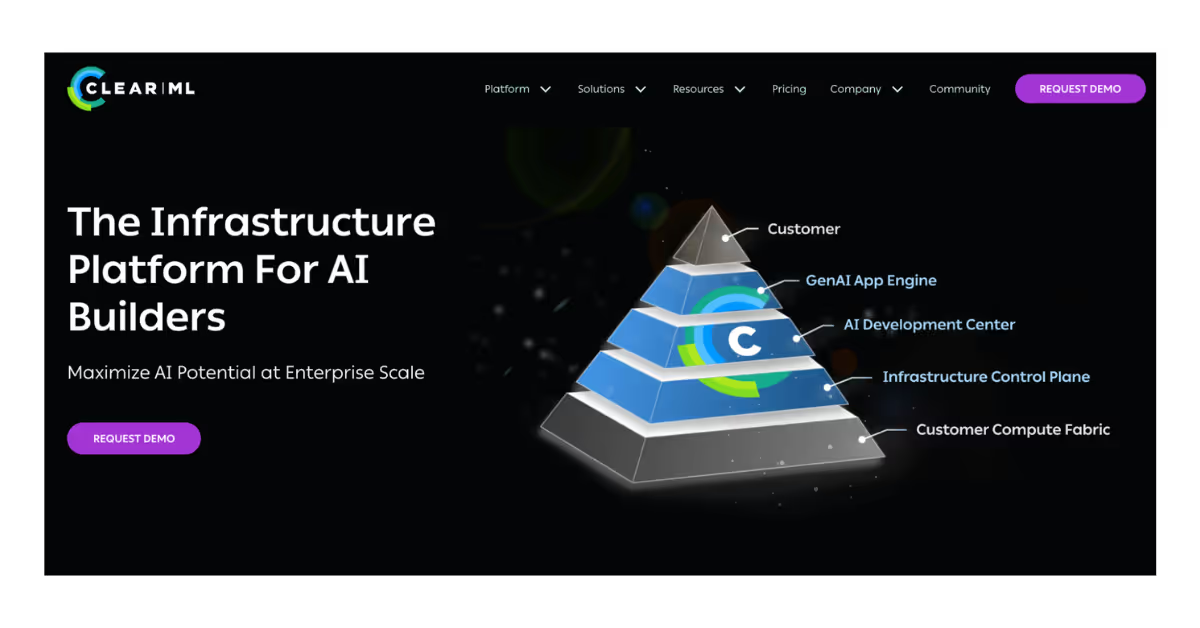
ClearML combines open-source accessibility with enterprise-grade features, serving 1,300+ enterprise customers including Microsoft, Facebook, Intel, and NVIDIA. The platform's three-layer architecture addresses infrastructure control, AI development, and GenAI applications through a unified interface with auto-magical integration capabilities.
Key Features:
- Auto-Magical Experiment Capture: Automatic logging of experiments with minimal code changes, capturing parameters, metrics, artifacts, and environment details without manual instrumentation
- Fractional GPU Support: Container-based memory limitation enabling efficient GPU resource utilization through sharing GPUs across multiple experiments and users
- AI Infrastructure Management: Comprehensive GPU cluster management with automatic provisioning, scaling, and resource optimization across cloud and on-premises environments
- Complete Data Versioning: Git-like versioning for datasets, models, and experiments with efficient storage on object storage systems and complete lineage tracking
- Kubernetes-Native Orchestration: Built-in support for Kubernetes deployment with custom resource definitions and integration with existing DevOps workflows
Use Cases:
- Enterprise AI Development: Large organizations requiring comprehensive MLOps capabilities with complete infrastructure control and security compliance
- Resource-Constrained Environments: Teams needing efficient GPU utilization and cost optimization through fractional resource allocation and automated scaling
- Hybrid Cloud Deployments: Organizations requiring consistent MLOps workflows across on-premises, cloud, and edge environments with centralized management
Real-World Example
According to SourceForge ClearML, BlackSky uses ClearML to accelerate AI/ML training in their Spectra AI platform, enabling automated analysis of satellite imagery for government and commercial applications while maintaining complete data security and compliance.
Pricing
Community Edition at no cost, with Pro ($15/user/month) and Enterprise tiers adding advanced features and support. Self-hosted deployment options ensure complete infrastructure control for security-sensitive environments.
Bottom Line
ClearML provides the most comprehensive open-source MLOps platform with enterprise features, ideal for organizations requiring complete infrastructure control with professional support. Perfect for teams balancing open-source flexibility with enterprise-grade capabilities.
10. H2O.ai - Complete AI Convergence Platform
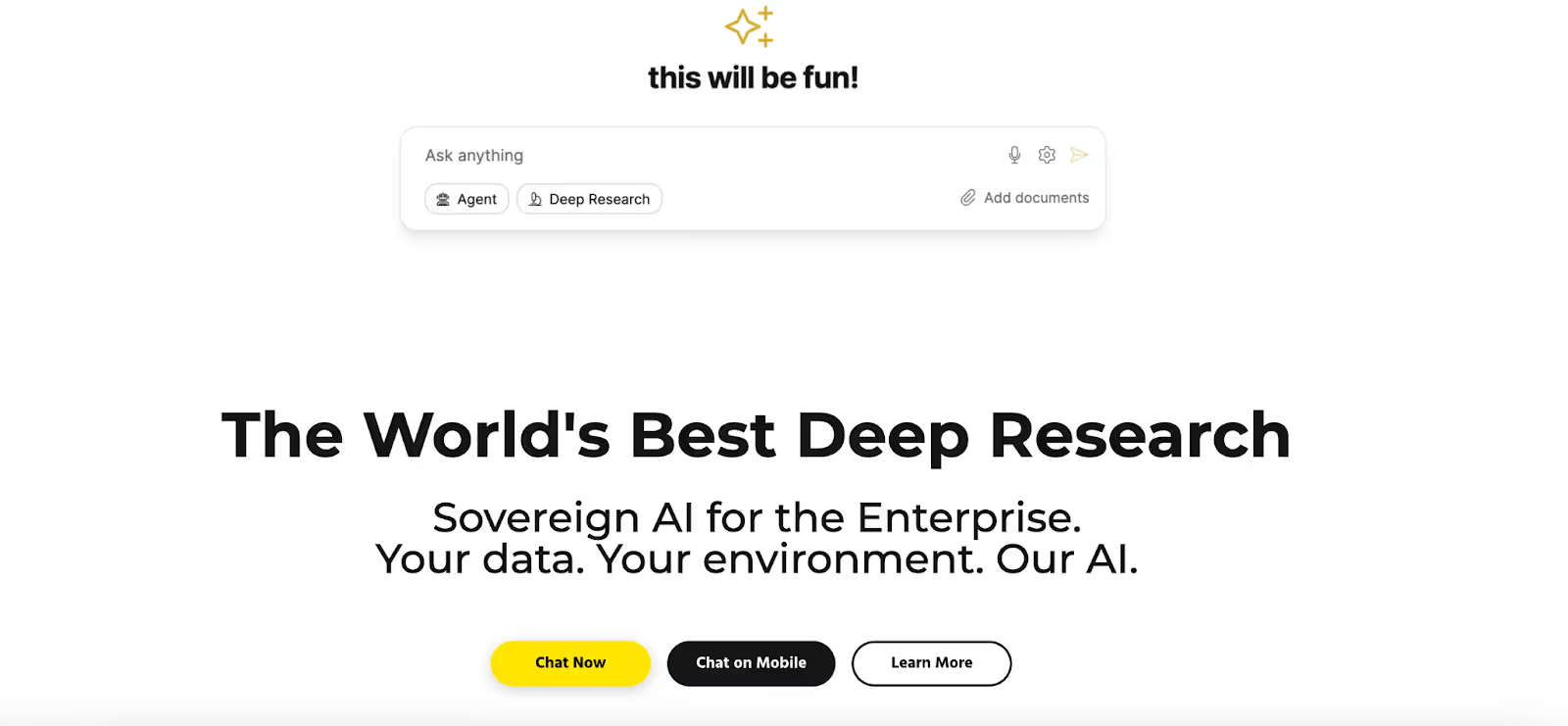
H2O.ai delivers complete AI convergence through predictive AI, generative AI, and agentic AI capabilities in a unified platform. Named a Visionary in Gartner's 2024 Magic Quadrant for Data Science and Machine Learning platforms, H2O.ai serves over 20,000 organizations globally with comprehensive AI solutions.
Key Features:
- Unified AI Platform: Integration of predictive modeling, generative AI, and autonomous agents in a single platform with consistent APIs and workflow management
- H2O Driverless AI: Automated machine learning with feature engineering, model selection, and hyperparameter optimization requiring minimal data science expertise
- Air-Gapped Deployment: Complete stack ownership for secure government and enterprise environments with on-premises deployment and data sovereignty guarantees
- Multi-Cloud MLOps: Model deployment and monitoring across AWS, Azure, Google Cloud, and hybrid environments with unified management and governance
- Industry-Specific Solutions: Pre-built solutions for financial services, healthcare, government, and manufacturing with compliance frameworks and regulatory support
Use Cases:
- Complete AI Transformation: Organizations seeking unified platforms for all AI capabilities rather than point solutions for specific use cases
- Regulated Industries: Financial services, healthcare, and government organizations requiring comprehensive compliance features and audit capabilities
- Automated ML Development: Teams with limited data science expertise requiring automated model development with enterprise-grade deployment capabilities
Real-World Example
A major financial institution uses H2O.ai for credit scoring and anti-money laundering across their global operations, processing millions of transactions daily while maintaining regulatory compliance and achieving 40% improvement in fraud detection accuracy.
Pricing
Open-source heritage through H2O-3 provides free access to core capabilities, while H2O AI Cloud offers SaaS deployment with flexible pricing. Enterprise support includes 24/7 assistance, dedicated account management, and custom deployment options.
Bottom Line
H2O.ai provides the most comprehensive AI platform for organizations seeking unified predictive and generative AI capabilities with strong compliance features. Ideal for enterprises requiring complete AI solutions with automated development and deployment capabilities.
Key Considerations for Selecting MLOps Platforms
Choosing the right MLOps platform requires careful evaluation of technical capabilities, organizational needs, and long-term strategic goals. The rapid evolution of the MLOps platforms market demands a systematic approach to avoid costly migrations and ensure scalable implementation.
Integration Requirements and Ecosystem Compatibility
Evaluate how well platforms integrate with your existing data infrastructure, cloud environments, and development tools. Organizations heavily invested in specific cloud ecosystems benefit from native platforms (SageMaker for AWS, Vertex AI for GCP), while cloud-agnostic teams may prefer MLflow or ClearML for maximum flexibility and avoiding vendor lock-in.
Team Expertise and Learning Curve Management
Assess your team's technical capabilities and willingness to invest in new skills. Platforms like Google Vertex AI and Azure ML minimize technical barriers through visual interfaces, while Kubernetes-native solutions like Kubeflow demand DevOps expertise but provide superior scalability for technical teams with container orchestration experience.
Scalability Planning and Performance Requirements
Consider both current workloads and future growth projections including model complexity, inference volume, and team size. Enterprise platforms handle massive concurrent workloads but may be overkill for smaller teams, while open-source solutions provide cost-effective starting points with clear upgrade paths as requirements evolve.
Model Deployment and Serving Capabilities
Evaluate deployment options including real-time APIs, batch processing, edge deployment, and A/B testing capabilities. Platforms like AWS SageMaker and Google Vertex AI excel at multi-modal deployment, while specialized tools focus exclusively on production serving optimization with advanced traffic management.
Monitoring, Governance, and Compliance Features
Assess built-in monitoring capabilities, audit trails, and regulatory compliance features. Comprehensive platforms like Databricks and H2O.ai provide built-in compliance frameworks, while open-source solutions require additional tooling for complete governance workflows in regulated industries.
Cost Structure and Total Ownership Analysis
Compare pricing models including platform fees, compute costs, storage charges, and support expenses. Azure ML's compute-only billing eliminates platform fees, while usage-based models like Neptune.ai align costs with actual utilization rather than time-based charges that may not reflect true resource consumption.
Industry-Specific MLOps Applications
Healthcare Organizations
Healthcare implementations prioritize HIPAA compliance, audit trails, and explainable AI capabilities. Azure ML and H2O.ai provide healthcare-specific features, while platforms like ClearML offer air-gapped deployment for sensitive medical data.
Financial Services
Financial services focus on fraud detection, regulatory reporting, and risk management applications. According to People in AI, 9 of the top 10 US banks employ dedicated ML operations roles, with platforms like Databricks and AWS SageMaker dominating due to their comprehensive governance features.
Retail and E-commerce
Retail implementations center on recommendation engines, demand forecasting, and dynamic pricing models. Real-time personalization requirements favor platforms like Google Vertex AI and Weights & Biases that excel at continuous model updates and A/B testing capabilities.
Manufacturing
Manufacturing adopts MLOps for predictive maintenance, quality control, and supply chain optimization. Edge deployment capabilities become important, making platforms like AWS SageMaker Edge and Azure IoT Edge particularly valuable for industrial environments.
Implementation Partnership Considerations
Organizations seeking MLOps implementation support should evaluate partners with proven track records in AI/ML deployment and operations. Azumo, a nearshore software development company, offers comprehensive MLOps services including model deployment, monitoring, and governance across major cloud platforms.
Azumo's MLOps capabilities span the complete ML lifecycle, from data engineering and pipeline management to model deployment and production monitoring. Their team of specialized MLOps engineers, data scientists, and AI software architects provides expertise in Apache Spark, Kubernetes, and major cloud platforms while maintaining cost advantages through their nearshore model.
Implementation partnership benefits include faster time-to-value, reduced technical risk, and access to specialized expertise without full-time hiring costs. Azumo's proven track record with enterprise clients like Facebook, United Health, and Discovery Networks demonstrates their ability to scale MLOps implementations across diverse industries and use cases.
Future MLOps Trends Shaping Platform Evolution
Generative AI Integration
Generative AI integration transforms traditional MLOps requirements through LLMOps capabilities, prompt engineering workflows, and foundation model fine-tuning. Platforms like Weights & Biases and Neptune.ai lead in GenAI-specific features, while enterprise platforms rapidly add LLM support to existing offerings.
Edge Computing Adoption
Edge computing adoption drives demand for lightweight deployment options and federated learning capabilities. MLOps platforms must balance model performance with resource constraints, creating opportunities for specialized solutions that optimize inference for edge environments.
Regulatory Compliance
Regulatory compliance increasingly influences platform selection as AI governance frameworks mature globally. The EU AI Act, GDPR requirements, and industry-specific regulations create demand for platforms with built-in compliance features and comprehensive audit capabilities.
Market Consolidation
Market consolidation continues as major cloud providers acquire specialized MLOps tools and integrate them into comprehensive platforms. Organizations should plan for potential vendor changes while selecting platforms with strong ecosystem integration and data portability.
Conclusion
The MLOps platforms landscape in 2025 offers unprecedented choice and capability, yet success depends on matching organizational needs with platform strengths rather than pursuing the most feature-rich solution. Enterprise teams with existing cloud investments should prioritize native platforms (AWS SageMaker, Google Vertex AI, Azure ML) for seamless integration and comprehensive support. Research-focused organizations benefit from specialized tools like Weights & Biases and Neptune.ai that excel at experiment tracking and foundation model development.
Open-source platforms like MLflow and ClearML provide cost-effective starting points with clear upgrade paths as requirements evolve, while comprehensive solutions like Databricks and H2O.ai serve data-heavy organizations requiring unified analytics and ML capabilities. The key lies in evaluating total cost of ownership, team expertise requirements, and long-term scalability needs rather than initial platform costs alone.
The explosive market growth projected through 2034 ensures continued innovation across all MLOps platforms categories, making flexibility and ecosystem integration more valuable than any single feature set. Organizations that align platform selection with their specific use cases, team capabilities, and infrastructure investments will capture the full value of their MLOps investments while maintaining agility for future evolution in this rapidly advancing field.
For organizations seeking expert guidance in MLOps implementation, Azumo offers comprehensive services spanning the complete ML lifecycle from data engineering to production monitoring. Their specialized team of MLOps engineers and AI architects provides proven expertise across major cloud platforms while delivering cost advantages through their nearshore development model, helping enterprises accelerate their AI transformation initiatives with reduced risk and faster time-to-value.


.avif)
